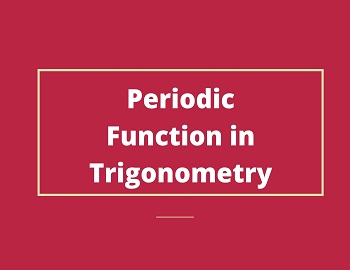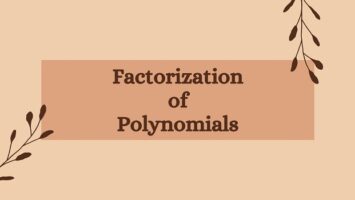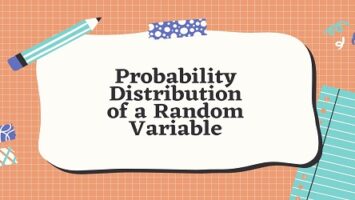Permutations:
The word permutation means arrangements. Each of the different arrangements that can be made by taking some or all of a given set of objects at a time is known as their permutation.
Thus, considering the letters A, B, and C of the English alphabet, the different permutations are as follows:
- by taking 1 at a time: A, B, C
- by taking 2 at a time: AB, BA, BC, CB, AC, CA
- by taking all at a time: ABC, ACB, BCA, BAC, CAB, CBA
The number of permutations of n things taken r at a time is noted by nPr or P(n, r). In the symbol nPr or P(n, r) both n and r are positive integers and n ≥ r.
Number of Permutations of n different things by taking r(n ≥ r) at a time:
Consider that n different things are n differently colored marbles and let r(r ≤ n) vacant holes are to be filled up by taking r marbles. So, the number of permutations of n different things taken r at a time will be the same as the number of ways in which the r holes can be filled up by taking r marbles from the set of n differently colored marbles at our disposal.
Now, any one of the n marbles can be placed in the first hole concerned. So, the first hole can be filled up in n different ways.
When the first hole has been filled up in any one of the n ways, there will be (n – 1) marbles and any one of them can be placed in the second hole. So, the second hole can be filled up in (n – 1) ways. As each way of filling up the first hole can be associated with each way of filling up the second, by the fundamental principle of multiplication, the first two holes can be filled up in n (n – 1) ways.
Now, when the first two holes have been filled up, the third hole can be filled up by any one of the remaining (n – 2) marbles and so the third hole can be filled up in (n – 2) different ways. Since each of these (n – 2) ways of filling up the third hole can be associated with the n (n – 1) ways of filling up the first two holes, the first three holes can be filled up in n (n – 1) (n – 2) ways.
So far three holes have been filled up and we find that the result contains as many factors as the number of holes filled up. Also, it is clear that as we proceed to fill up a new hole, the number of factors goes on increasing by a new factor and each new is one less than the previous factor.
Thus, the number of ways in which r holes can be filled up = n (n – 1) (n – 2) … to r factors. Here, the rth factor, n – (r – 1) = n – r + 1.
Hence, the required number of permutations,
| nPr = n (n – 1) (n – 2) (n – 3) … (n – r + 1) ⇒ nPr = [n (n – 1) (n – 2) (n – 3) … (n – r + 1) (n – r) (n – r – 1) … 4 . 3 . 2 . 1] / [(n – r) (n – r- 1) … 4 . 3 . 2 . 1] ⇒ nPr = n!/(n – r)! |
| Corollary 1: If all the n things are taken at a time, then the number of permutations = n (n – 1) (n – 2) … (n – n + 1) = n (n – 1) (n – 2) … 3. 2. 1 = n! ∴ nPn = n! …….. (i) Now, in factorial notaion nPr = n!/(n – r)! Putting r = n, we get nPn = n!/(n – n)! = n!/0! …….. (ii) From (i) and (ii) it is clear that n! = n!/0! = 0! = 1 …….. (iii) |
| Corollary 2: nPn – 1 = n! / [n – (n – 1)]! = n!/1! = n! …….. (iv) Also, nPn = n!, from (i) ∴ nPn – 1 = nPn Thus, for a given value of n, nPr is greatest when r = 0 or n – 1. |
| Corollary 3: The number of permutations of n different things taken 1, 2, 3, … n at a time is given by nP1 + nP2 + nP3 + … nPn. |
| Example 1: If nP2 : nP3 = 1 : 3, find n. Solution- nP2/nP3 = 1/3 ⇒ [n (n – 1)]/[n (n – 1) (n – 2)] = 1/3 ⇒ 3 = n – 2 ⇒ n = 5 Example 2: If xP5 : 2 = xP3, find x. Solution- xP5/2 = xP3 ⇒ [x (x – 1) (x – 2) (x – 3) (x – 4)]/2 = x (x – 1) (x – 2) ⇒ (x – 3) (x – 4) = 2 ⇒ (x – 3) (x – 4) = 2 x 1 ⇒ x – 3 = 2 ⇒ x = 5 Example 3: If m+nP2 = 90 and m-nP2 = 30, find m and n. Solution- m+nP2 = 90 ⇒ (m + n) (m + n – 1) = 10 x 9 ⇒ m + n = 10 ……….(i) Also, m-nP2 = 30 ⇒ (m – n) (m – n – 1) = 6 x 5 ⇒ m – n = 6 ……….(ii) Subtract (ii) from (i): (m + n) – (m – n) = 10 – 6 ⇒ 2n = 4 ⇒ n = 2 Substitute n = 2 in equation (ii) m – 2 = 6 ⇒ m = 8 |
| Example 4: How many different 8 letter words can be formed out of the letters of the word LAUGHTER so that- (i) Each word began with L. (ii) Each word began with L and ends with R. (iii) L and R are at the end places. (iv) The vowels are together. (v) Vowels are never together. (vi) Vowels are at even places. Solution- The number of letters of the word LAUGHTER = 8, so these 8 alphabets can be arranged in 8! ways. ∴ Total number of words = 8! = 40320 (i) Each word began with L so that the first place can be filled in one way. Now the remaining seven alphabets can be arranged in the remaining seven positions in 7! ways. ∴ total number of arrangement = 1 x 7! = 5040 (ii) Since each word began with L and ends with R, so the first and the last place can be filled in one way each. Now the remaining six alphabets can be arranged in 6P6 ways. ∴ total number of ways = 1 x 6P6 x 1 = 6! = 720 (iii) Since L and R are at the end places so both can arrange in 2! ways. Now the remaining six alphabets can be arranged in 6P6 ways. ∴ total number of ways = 2! x 6P6 = 2! x 6! = 2 x 720 = 1440 (iv) Number of vowels = 3 (A, U, E) Since the vowels are always together so consider them as one alphabet. Now the remaining five alphabets and one considered alphabet can be arranged in 6P6 ways. Also, the three vowels themselves can be arranged in 3P3 ways. ∴ total number of arrangements = 6P6 x 3P3 = 6! x 3! = 720 x 6 = 4320 (v) Number of ways in which vowels are never together = Total arrangement – Number of ways in which vowels are together = 8! – (6! x 3!) = 40320 – 4320 = 36000 (vi) Number of even places = 4 Number of vowels = 3 Now the three vowels can be arranged on these four places in 4P3 ways. Also, the five consonants can be arranged on the remaining five positions in 5P5 ways. ∴ total number of arrangement = 4P3 x 5P5 = 4 x 3 x 2 x 5! = 24 x 120 = 2880 |
| Example 5: If 10 students appear in an examination and 4 of them are appearing for mathematics and the rest for six different subjects, in how many ways can they be seated in a row so that no copying is possible? Solution- Six students of different subjects can be arranged in 6P6 ways = 6! ways. For no copying in the examination, we have to arrange the four students of mathematics on the seven positions created between 6 students of different subjects. So four students can be arranged in these seven positions in 7P4 ways. ∴ total number of arrangements = 7P4 x 6P6 = 7 x 6 x 5 x 4 x 6! = 840 x 720 = 604800 Example 6: Find the number of different 5 letter words with the letters of the word EQUATION which start with a vowel. Solution- Number of vowels = 5 Since each word began with a vowel so the first place can be filled in 5 ways. Now the remaining four positions can be filled from the remaining seven alphabets in 7P4 ways. ∴ total number of arrangement = 5 x 7P4 = 4200 |
| Example 7: In how many of the permutations of the letters of the word SYNDICATE taken 4 at a time will there be (i) no vowel (ii) at least one vowel? Solution- Number of letters in the word SYNDICATE = 9 Number of vowels = 3 (i) Since in a four letter word there is no vowel so the four letter word can be formed from the six consonants in 6P4 ways. ∴ Number of ways in which there is no vowel = 6P4 = 360 (ii) Number of ways in which there is at least one vowel = Total arrangments – Number of ways in which there is no vowel = 9P4 – 6P4 = 3024 – 360 = 2664 |









Comments (No)